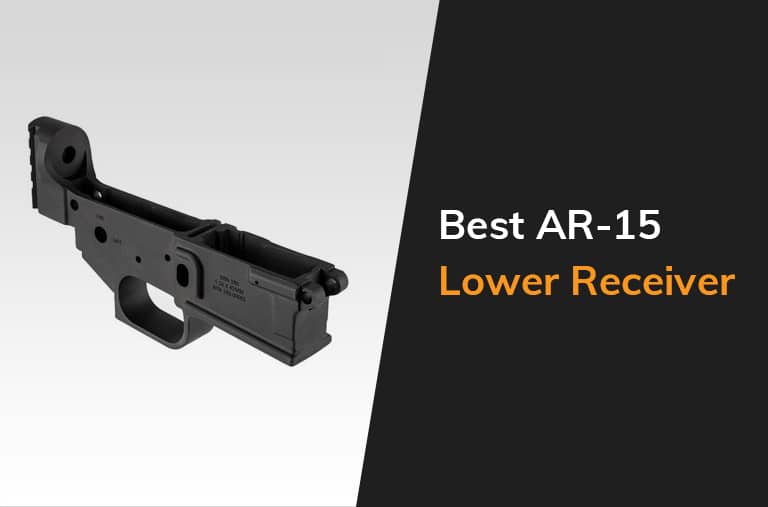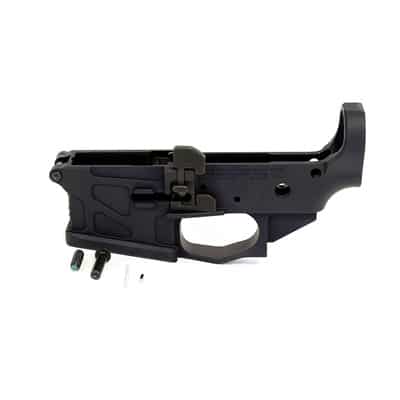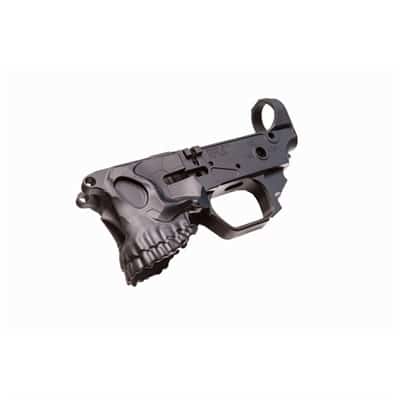At a Glance: Best AR-15 Lower Receivers
- OUR TOP PICK: Brownells – BRN-180 Stripped Lower Receiver Forged
- RUNNER UP: Polymer80 – AR-15 80% Polymer Lower Receiver & Jig Kit
- BEST BUDGET OPTION: Anderson Manufacturing – AR-15 80% Lower Receiver Black Anodized
Comparison of The Best AR-15 Lower Receivers
| PRODUCT | DETAILS | ||
|---|---|---|---|
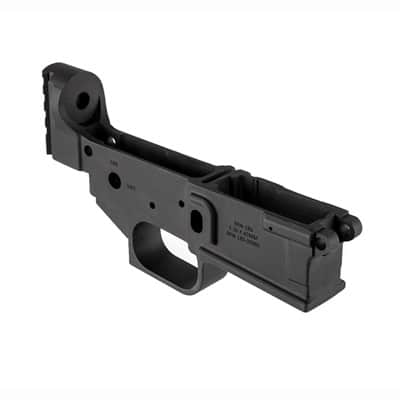
Our Top Pick
|
Brownells – BRN-180 Stripped Lower Receiver Forged |
|
View Latest Price |
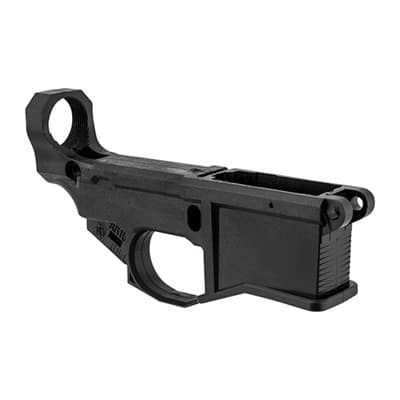
Our Top Pick
|
Polymer80 – AR-15 80% Polymer Lower Receiver & Jig Kit |
|
View Latest Price |

|
Anderson Manufacturing – AR-15 80% Lower Receiver Black Anodized |
|
View Latest Price |
Our List Of The Best AR15 Lower Receivers
As it is the AR15 component that is legally the registerable firearm, the lower receiver can be considered the most important part of an AR-15. There are hundreds of options to choose from when building an AR. That makes the AR-15 super versatile. You can attach custom parts to your AR-15 lower and come away with an almost completely new gun.
In this article we are reviewing five best AR-15 lowers currently on the market. We looked at their quality, durability, ease of installation and use, accuracy and precision, and, of course, price. Get ready for a fun ride.
Brownells – BRN-180 Stripped Lower Receiver Forged
The BRN-180 lower receiver is based on the 1963 AR-18 rifle’s design. It has all the old-school visual lines yet includes all modern AR-15 lower features.
KEY FEATURES
- Forged 7075 aluminum with anodized finish
- Accepts standard Mil-Spec AR-15 lower receiver parts kits
- 1913 picatinny stock/brace mounting section
At the rear of the BRN-180 lower receiver, you will find a 1913 Picatinny rail section. That works great for attaching a stock for an AR-15 rifle/SBR or a pistol brace.
Pros
- Forged from 7075 aluminum alloy
- Good Value
- Very durable , High quality
- 1913 Picatinny stock/brace mounting section
Cons
- Quite heavy
- Fitting Required
Polymer80 – AR-15 80% Polymer Lower Receiver & Jig Kit
This Polymer80 product has everything you need to start building a completef AR-15 lower. The AR-15 lower is made from a single piece of polymer. It is only 80% finished which means no Federal Firearm Licence (FFL) is needed. However, it requires the final milling of the fire control group, trigger pin and slot, hammer pin, and safety selector. There is a jig kit included that makes the drilling and milling easier. It also contains all the necessary drill bits and a milling bits to make the lower complete. Jig screws are not included. When milling the fire control group, make sure to go the entire 1.249 inches deep otherwise the trigger won’t work.
Pros
- Can be delivered directly to your doorstep
- No FFL required
- Includes everything to build a complete AR-15 lower
- Made from durable polymer
- Super lightweight
- Very cheap
Cons
- Might not last as long as an aluminum lower
- Jigs not included
Anderson Manufacturing – AR-15 80% Lower Receiver Black Anodized
The Anderson Manufacturing AR-15 80% lower receiver is forged from 7075-T6 aluminum. It is black anodized. It is only 80% finished and requires drilling and milling to complete. However, an FFL is not needed and you can have it shipped directly to your house. Things you need to do or have to complete this lower include milling the fire control/trigger group and the safety selector hole, and getting a trigger pin, hammer pin, and a trigger slot. This is a very affordable lower but it does not include a jig kit. You need to get that separately. Any standard lower parts kit will install perfectly. The only downside is that the rear takedown pin pocket is undersized. That means no commercially available upper will fit in unless you mill it.
Pros
- Forged from 7075 aluminum alloy
- Durable
- Black anodized finish
- Very affordable
Cons
- No jig kit included
- The rear slot to attach the upper is too small and has to be milled
American Defense manufacturing – AR-15 UIC15 Stripped Lower Receiver Ambidextrous
This is a higher price range AR-15 lower loaded with great next-gen features. It is machined with radii and chamfer cuts for a cool look. The AR-15 lower has a 20-degree magazine well cut for faster reloads. The magazine well also features reinforcing ribs that make it 40% stronger than a mil-spec forged one at only half-ounce of weight change. The trigger guard is big enough to allow you to wear winter gloves. The greatest parts of this AR-15 lower are its ambidextrous magazine release, bolt release, bolt catch, dimpled takedown, and pivot pins. The finish is Teflon-impregnated and anodized which reduces friction and helps protect it. This is classified as a firearm and requires FFL.
Pros
- Machined from 7075 billet
- Teflon impregnated anodized finish
- Fast magazine changes
- Reinforcing ribs
- Ambidextrous
Cons
- Higher price
Sharps Bros – AR-15 Gen 2 The Jack Lower Receiver Black
This is a cool AR-15 lower with an innovative design. It features an integrated skull design on the magazine well which reduces the overall weight of the lower receiver by removing excess material. The AR-15 lower is machined from solid billet blocks of 7075-T6 aluminum and molded into their final eye-catching design by skilled craftsmen. This lower is loaded with cool features like threaded bolt-catch pins. The trigger guard is oversized which allows for easy control even in winter gloves. The AR-15 lower also includes beveled magazine flares, which aid shooters in performing rapid reloads. It is anodized and compatible with mil-spec internal components. That means you can use any standard AR-15 lower parts kit to complete the build. The same applies to any standard AR-15 upper and any standard-capacity AR-15 magazines on the market.
Pros
- Machined from 7075-T6 aluminum alloy
- Threaded bolt catch pin
- Oversized trigger guard
- Rapid reloads
- Multi caliber
- Compatible with any standard lower parts kit and AR-15 upper
- Anodized finish
- Super cool look
Cons
- Most expensive
What is an AR-15 Lower Receiver?
The simple answer is: an AR-15 lower receiver is the part of the rifle (or pistol) that houses the fire control group, lower parts kit, magazine well, and pistol grip. It connects the buffer assembly and stock to the AR-15 rifle (in the case of an AR-15 pistol, it attaches just to the buffer tube). There are, however, important laws defining what an AR-15 lower receiver actually is.
As mentioned above, the AR-15 lower is the only part considered a firearm by the Bureau of Alcohol, Tobacco, Firearms, and Explosives (ATF). Even if it is just a stripped lower without a barrel, stock, fire control group, or other parts, it is still considered a firearm, with the following consequences:
- You can’t have it shipped directly to your house,
- You have to buy it with an FFL,
- Background checks, sales taxes and waiting periods are included in the process, and
- You can possess one only if the state you reside in allows it.
How to Choose an AR-15 Lower Receiver
There are many AR-15 lower receivers on the market currently. It is actually pretty easy to start making them yourself in your garage, you would just need some permits from the ATF and to fulfill some legal requirements. However, we do not recommend that at all if you are new to the AR-15 world. Here is what you need to look for when you want to buy a good AR-15 lower receiver. This video is also very informative.
- Choose a renowned brand for good quality.
- Check that the lower has a serial number, the name of the manufacturer and the city where it was made stamped on the lower.
- What type of material is it made from? Aluminum is the most common material used. Some AR-15 lowers are made from carbon-fiber/polymer. Both are super light and cheaper than aluminum and you will certainly appreciate them when going on hunting trips. On the other hand, it might not be as durable as aluminum is.
- How it was made?
- Forged – best
- Billet – good
- Cast – acceptable
- What type of magazine well does the AR-15 lower have?
- A tapered magazine well allows you to do tactical reloads because one side is wider than the other.
- A regular magazine well has straight sides so you need to hit it straight in when reloading.
- What kind of accessories will you add to your AR-15? For example, is a trigger guard included or not, meaning you can choose your own (e.g. getting a bigger one so you can shoot while wearing gloves).
- Is it ambidextrous or not? Having an ambidextrous AR-15 lower can be quite useful when shooting tactically with either hand. For example, an ambidextrous bolt release or magazine release needs to be on both sides of the lower for quick shooting options. Such a feature will be incorporated in the AR-15 lower. On the other hand, you can always buy some accessories and install them on the gun to make it ambidextrous.
- Are you going to be able to build your AR-15 lower yourself? AR-15 lowers often come as a stripped-down piece of metal and you need to install all the other parts. You can buy a kit to save yourself some time to look for parts. There are also pre-built/complete AR-15 lower receivers which save you time but not money.
- Last but not least, you should consider buying your AR-15 lower and upper from the same company as they will fit the best for each other.
Stripped AR-15 Lower Receivers vs 80% Lowers vs Complete Lower Receivers
There are three different types of AR-15 lower receivers based on how finished and ready to use they are and whether they are legally considered a firearm or not.
- A stripped lower is a lower receiver without a lower parts kit. It is a 100% lower and is classified as a firearm. As such it is subject to all laws. It allows you to pick and choose each part that goes inside which makes it fun to work with. It is usually cheaper than a complete lower since you need to buy the lower parts kit to make it fully functioning.
- 80% AR-15 lower receivers are not considered firearms. Since they are only 80% complete in terms of raw manufacturing, they cannot accept a fire control group. Thanks to that, they can be shipped to your home directly. This allows shooters to build their rifles from scratch, including milling the aluminum. It is more challenging but also more rewarding. It requires some patience but it is also the cheapest route to go.
- A complete AR-15 lower includes a variety of components and receivers which are already put together. You just attach it to a complete upper and you are ready to shoot. It is considered a firearm and is fully regulated by law. This term can mean:
- A pre-built AR-15 lower receiver with lower parts kit and buffer that is ready to be used. It is classified as a firearm.
- An 80% AR-15 lower receiver completed by milling out the fire control pocket. It is considered “completed” after the first hole is drilled into the fire control pocket. From this moment on, it becomes a firearm that is illegal to sell or give to anybody without proper licenses.
Types of AR-15 lower receivers based on material
There are different types of AR-15 lowers based on the material they are made from.
Billet
Billet aluminum AR-15 lower receivers are cut from a solid block, usually of raw 6061 T6 aluminum alloy that is called “bar stock”. The bar stock is an important factor in producing a precise, high quality lower receiver. The raw material is extruded to ensure the aluminum alloy is durable and consistent. The extrusion process means shaping the raw aluminum by pushing it through a series of high-pressure machine rollers.
- The raw bar stock is heated and rolled into an extrusion chamber.
- At the end of the chamber is the extrusion press.
- The large hydraulic extrusion press pushes the bar stock through a shaped metal die into a lower receiver shape.
- The process hardens the metal and aligns its crystalline structure ensuring the toughness and consistency of the material.
The pros of billet lower:
- Thicker walls
- Resists higher pressures
- Accommodates more weight on the barrel
- Resistant to higher recoil forces
- Optimal for long, heavy AR calibers like a .308 or 6.5
- Can be cut in different shapes and designs
- Usually includes threaded fittings
- Strong and lightweight if made from 6061 T6 aluminum, heavier if made form 7075 T6 aluminum
The cons of billet lower:
-
- Usually more expensive
- Billet aluminum is not as strong as forged aluminum
Forged
A forged aluminum AR-15 lower is the toughest and the most affordable type of AR-15 lower receiver. It requires less machining than the billet AR-15 lower. That makes it the strongest and more affordable than a billet AR-15 lower.
- Forged lowers are made from 7075 T6 aluminum alloy.
- First, they are heated to high temperatures,
- Then formed into shape using large hammer presses.
- This process is repeated to purify the metal by removing the slag which forms sparks that fly off the bar stock when it is being hammered.
- The pounding of the metal organizes the molecular structure making the metal super strong and consistent.
Forged lowers can accommodate much higher internal pressures inside the chamber when a round is fired. That makes them perfect for rifles that will see a lot of rapid shooting, like M4 or M16 type rifles. The only downside of the forged AR-15 lower is the fact that it can’t be shaped into a cool, aesthetically pleasing design and will always look kind of plain compared to a billet one.
Polymer
Polymer/carbon-fiber lowers are relatively new to the AR-15 market. They have been around for some handguns and sub-machine guns but until recently polymer was not capable of handling the high stress and pressure of supersonic ammunition. To make the receiver:
- Molten plastic granules are mixed with nylon fibers to create a weapons-grade polymer,
- The polymer is poured into a receiver mold,
- After cooling off, the roughly formed receiver is removed, and
- Final fittings and features are cut and drilled.
The pros of polymer lowers are that they are:
- Super lightweight (half of the forged lower)
- Easy to assemble at home
- Super affordable
The downside of polymer is the fact that it is the least strong and durable and the signs of surface wear will be more visible.
- Cast AR-15 lowers are made by simply heating and pouring molten aluminum into a shaped mold, similar to a polymer lower. There are no presses used to get rid of slag or to form the receiver. The heating and cooling of the aluminum can cause microscopic defects on the lower. These defects can be magnified while firing the AR-15 and cause injuries. This doesn’t happen to polymer as it naturally forms a strong molecular structure after being heated. I would recommend against getting a cast aluminum AR-15 lower.
6061-T6 vs 7075-T6 Aluminum AR-15 Lower Receivers
As mentioned above, there are two different types of aluminum alloys used to produce AR-15 lower receivers. At first sight, they look pretty similar. Both contain magnesium, silicon, copper, iron, zinc, titanium, manganese, and chromium. The difference between these two rests in how much of each element is present in each alloy.
| 7075-T6 aluminum alloy | 6061-T6 aluminum alloy |
|
|
AR-15 Lower Receiver Finishes
Since AR-15s became widely popular, finishing for AR-15 lower receivers became a diverse industry as well. There are multiple choices of finishes on the market:
- Anodizing is the toughest finish available, proven by the U.S. military. Anodizing is an electromechanical process that makes your AR-15 lower resist rust, damage, and protect it. Only solid colors are available.
- Kameleon Kamo is one of the most unique firearms finishes. It is supposed to let your firearm blend in with its surroundings better than traditional camo patterns. If you give your lower receiver this finish you will certainly end up with the most unique rifle on the range.
- Duracoat is a simple and affordable custom firearm finish. Although it is called spray paint for guns, it is a lot tougher than spray paint. Duracoat is simple and easy to apply. If it gets scatched or marred it can be easily fixed.
- Cerakote is a ceramic-based gun finish that is incredibly durable, and extremely hard. It can be used like the duracoat to create cool designs but it is trickier to apply and requires more specialized equipment.
- Hydro Dipping uses water to transfer custom patterns onto a gun. Hydro dipping can be used for lower receivers, magazines, furniture, and more. It is very cheap and would work on a hunting rifle but might not last very long.
Conclusion
As you can see from our reviews there are a lot of things to be taken into consideration when choosing your first/next AR-15 lower receiver. Depending on what you will be using your AR-15 for you should consider one of the following AR-15 lowers.
- If you are planning to go hunting with your AR-15, you should probably go for the Polymer80.
- If you want to save money and build your own lower from scratch, then get the Anderson Manufacturing 80% or Polymer80.
- If you want to be the coolest kid at the range and have money to burn then you NEED The Jack from the Sharps Bros’.
- Wanna try ambidextrous lower and other cool features, American Defense UIC15 is calling your name.
- And if you are like me who just wants a super durable forged stripped lower then BRN-180 is your choice.

